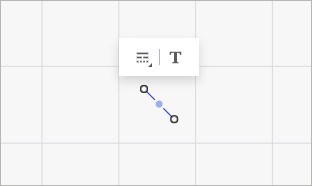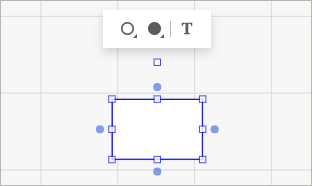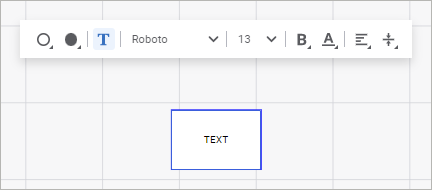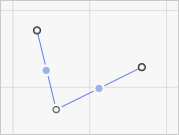In this article:
Setting Up Working Area Formatting
Adding Calculation Algorithm Formatting Objects
Setting Up Calculation Algorithm Formatting
To set up calculation algorithm formatting:
NOTE. Setting up formatting of calculation algorithm blocks, repository objects and nested calculation algorithms is similar to setting up text block formatting.
Setting Up Working Area Formatting
To set up working area formatting, click the  Working Area Parameters button on the toolbar. After this the Working Area Settings side panel opens:
Working Area Parameters button on the toolbar. After this the Working Area Settings side panel opens:

Set the parameters:
Show Grid. Deselect the checkbox to hide grid in the working area. The checkbox is selected by default, grid is shown.
Show Intersections. Select the checkbox to show line bends at the points of intersection of straight/curved lines and arrows in the working area:

The checkbox is deselected by default, line bends are not displayed at the points of intersection of straight/curved lines and arrows. Checkbox state is not saved, and the checkbox is always deselected on opening calculation algorithm.
Background Color/Grid Color. Select background/grid color in the drop-down color palette.
One can select standard and custom colors. The palette contains only standard colors by default.
To create a custom color:
Click the
 Add Color button. The advanced color palette opens.
Add Color button. The advanced color palette opens.
Select a color in the advanced color palette, use color picker to select color on a browser page, or set color code in the RGB or HEX format.
After executing the operations the custom color is created and added to the palette.
NOTE. The maximum possible number of custom colors in the a palette is 23.
To delete custom color from the palette, select the Delete item in the selected color's context menu.
To change color transparency, use the slider or enter value as a percentage.
To reset color settings, click the  Default Color button.
Default Color button.
To hide or show grid in the working area, press the G key.
Adding Calculation Algorithm Formatting Objects
To set up calculation algorithm formatting, use the following objects:
Lines. They are used to create visual links between elements.
Shapes. They are used to create visual blocks.
Callouts. They are used to create comments and notes for elements.
Text. It is used to create labels, comments, captions explaining purpose of blocks and objects.
Images. They are used to create visual elements.
To add a calculation algorithm formatting object:
To manage calculation algorithm formatting objects, see the Managing Calculation Algorithm Elements section.
Setting Up Calculation Algorithm Formatting Objects
By default, all objects used for visual structuring of calculation algorithm and working area elements have the same formatting. To set up selected object formatting, set formatting parameters on the popup panel:
For a line:

For a shape/image:

For a callout:

For a text block:

Set:
Entering and Editing Text
To enter and edit line/shape/callout/text block text:
Double-click the selected object.
Select the Rename context menu item.
Click the
 Add/Edit Text button on the popup panel of the selected object.
Add/Edit Text button on the popup panel of the selected object.
The text editor is displayed. To finish text editing, click outside the editor area.
To set up text formatting of the selected object, use the popup panel:

Set text parameters:
To set mixed text formatting, change font options of the selected text part.
Adding and Setting Up Image
To add an image to shape/text block:
Select shape/text block.
Select the Select Image item in the drop-down menu of the
 Image in Shape button on the popup panel.
Image in Shape button on the popup panel.
After the image file is selected, the image is added to the text block or shape and is fit to its borders.
To set up the image in the working area, select the Set Up Image item in the drop-down menu of the  Image in Shape button on the popup panel. After this the Image Settings side panel opens:
Image in Shape button on the popup panel. After this the Image Settings side panel opens:

Set the parameters:
Alignment. Set image position in the shape. By default, the image is aligned to center relative to vertical and horizontal borders of the shape.
Border margins, mm. Set additional image margins inside the shape.
Image Parameters. Set the following parameters:
Zoom Mode. Select image resize mode relative to shape sizes:
Do not Resize. Original image size is kept. If the image is larger than the shape, it is out of the shape borders.
Lock Aspect Ratio. Image size is fit proportionally to the width and height ratio of the shape.
Stretch. The image is stretched to fit the shape taking into account the specified margins.
Transparency. Set image transparency degree. Available values are in the range [0, 80].
To delete image:
Select the image in the working area, table block or shape containing the image.
Select the Delete Image item in the drop-down menu of the
 Image in Shape button on the popup panel.
Image in Shape button on the popup panel.
After executing the operations the image is deleted from the working area or from the table block or shape.

 Add a line
Add a line . Straight line.
. Straight line. . Arrow.
. Arrow. . Angular line.
. Angular line. . Curved line.
. Curved line.
 . Rounded rectangle.
. Rounded rectangle. . Rectangle.
. Rectangle. . Ellipse.
. Ellipse. . Triangle.
. Triangle. . Tetragon.
. Tetragon. . Pentagon.
. Pentagon. . Hexagon.
. Hexagon. . Octagon.
. Octagon. . Rectangular callout.
. Rectangular callout. . Rounded rectangular callout.
. Rounded rectangular callout. . Oval callout.
. Oval callout. Start/
Start/
 Swap Places With button.
Swap Places With button. Line Color button.
Line Color button. No Color button.
No Color button. Set Up Line button:
Set Up Line button: . Solid line.
. Solid line. . Squared points.
. Squared points. . Dashed line.
. Dashed line. . Dash-dot-dot-dashed line.
. Dash-dot-dot-dashed line. . Dash-dot-dashed line.
. Dash-dot-dashed line. Border Color button.
Border Color button. Fill Color button.
Fill Color button. Border Color button.
Border Color button. Font Style button:
Font Style button: . Italic.
. Italic. . Underline.
. Underline. . Strikethrough.
. Strikethrough. Font Color button and select font color in the drop-down color palette.
Font Color button and select font color in the drop-down color palette. Horizontal Alignment button:
Horizontal Alignment button: . Center. It is used by default.
. Center. It is used by default. . Right.
. Right. Vertical Alignment button:
Vertical Alignment button: . Top.
. Top. . Bottom.
. Bottom.